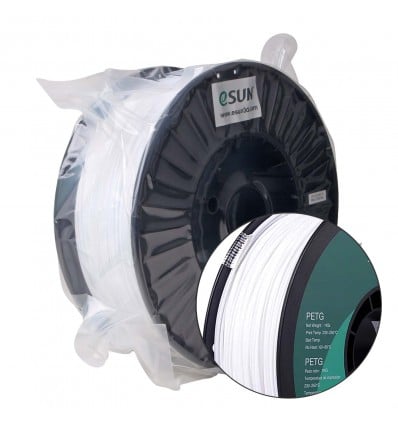International shipping Secure payment
No products
Prices are tax included
Product successfully added to your shopping cart
There are 0 items in your cart. There is 1 item in your cart.
These 2.5kg rolls of 1.75mm Solid White PETG Filament offers great subtle style and resilience against everyday scuffs or scrapes, great for post-process painting.
This product is no longer in stock
Free shipping on orders over R1250 - courier delivery and within South Africa
Please Note: eSun has recently changed their filament spool material. You may receive a cardboard spool, instead of the plastic spools depicted above. This move means a more environmentally friendly design to their 3D filament spools which comfortably sit on your 3D printer's standard spool holder for smooth filament feeding.
It’s always exciting to see how far we’ve come in the world of 3D Printing, going from the original two polymers, ABS and PLA, to now having over 15 different types of Exotic Filaments to print with. And while many people may be surprised and somewhat overwhelmed at the many choices of polymers available, each of these polymers offer a unique set of strengths and weaknesses – with each one being particularly good at a specific range of applications.
One of the most widely used and popular plastics that has been introduced to 3D Printing over the past decade or so is PETG filament, which is the plastic that many bottles, containers and similar types of products are made from. It offers an impressive level of durability against impacts and scraping, but also a good level of flexibility if it’s not printed too thick. This is what makes our 2.5kg spools of Solid White 1.75mm PETG from eSUN such popular choices, since PETG seems to offer the best of both worlds while also being environmentally friendly and easy to recycle.
The PETG polymer, in addition to the above benefits, is also hydrophobic and resistant to absorbing water and moisture. This allows it to last a lot longer than other 3D Printer Filaments once opened, which is especially important if you live in very humid areas like along the coast. Furthermore, this polymer melts into liquid form very smoothly, which helps to improve extrusion and in turn boosts the potential quality of prints. These features, in conjunction with the high durability, impact strength and flexibility, make PETG plastic one of the most versatile and multifunctional plastics available to hobbyists and professionals alike.
eSun PETG Filament - Technical Specifications: |
|
|
– eSun |
|
– Polyethylene Terephthalate (PET) |
|
– Glycol |
|
– 1.75mm |
|
– 2.5kg |
SA Filament PETG Filament – Suggested Print Settings: |
|
|
– 210 to 250 |
|
– Brass / Any |
|
– Standard: 0.4mm |
|
– 70 to 90 |
|
|
|
– 30 to 60 |
|
– Off, But Print Slowly | Fan On for Bridging |
|
– Not Necessary |
|
– N/A |
|
– N/A |
|
– Sanding / Polishing Compound / XTC Coating |
Helpful Tips for 3D Printing with eSUN PETG Filament:
3D Printing with the durable and slightly flexible PETG polymer is quite a unique experience, as it offers very similar characteristics to ABS, but uses similar printing specifications to PLA. This is why many 3D Makers argue that PETG is the perfect balance between ABS and PLA polymers, offering high strength but also being relatively easy to print with compared to some of the filaments and polymers with stricter parameters.
However, if you really want to get the most out of your PETG prints, and enjoy both durable and aesthetically awesome-looking results, we’ve collected following insights, which we feel are some of the most important factors, and which we feel are the most important factors to experiment with when “dialling in” your 3D Printer:
- PETG Printing Tips – First Layer Adhesion: Although it may come as second nature to try and get the squishiest squish-factor around for all kinds of filaments and polymers, PETG is a little different, and actually shouldn’t be squished too hard for the first layer. In fact, it’s good practice when printing with PETG to have your first layer print at around 125% of the defined layer height. This will give it the ability to “grab” the following layers more effectively, and because PETG layers tend to bond well to each other, this dramatically helps with the overall print quality. This is primarily due to the glass transition temperature of around 85°C for PETG, as well as how the heatbed draws heat away from the first layer due to the direct contact with the thermally conductive heatbed.
- PETG Printing Tips – Effective Bridging: With PETG Filament, one of the more difficult factors to get right is bridging between parts, as PETG tends to sag quite dramatically due to the high temperatures required for printing. However, it’s important to note that this is more so for opaque than transparent colours, as the colourants can affect the overall chemical composition of the material being printed. As such, it will take some time to dial in just right, depending on the colour and brand you’re using, but for most cases, it’s prudent to print bridges quite slowly, turn the fan on if you’ve got it off, and then define a bridge overlap of around 1mm. This will help prevent the bridging strands from curling upwards as they’re printing, while also adding some strength to the edges so the strands stick well and don’t pull themselves loose.
- PETG Printing Tips – Strength vs Aesthetics: This factor is certainly one that we love about PETG, and is also a factor that seems quite undervalued in most 3D Maker communities, but with PETG filament you can actually distinctly choose whether you want to focus more on durability and strength, or aesthetics and detail quality. In fact, choosing which you would like to focus on is as simple as defining whether the fan is turned on or off for the print, as printing PETG with the fan on tends to produce a great surface finish, while printing PETG with the fan off helps with layer bonding and lamination, lending itself well to high-strength parts instead. Of course, you could always choose the best of both worlds by printing for strength and post-processing for aesthetics, but if you’re not interested in post-processing your prints afterwards, then the above rule is quite easy to utilise for whatever application your print is being made for.
- PETG Printing Tips – Infill & Top Layers: While it’s typical for people to assume that higher levels of infill result in higher strength prints, the truth is that high infill doesn’t always equal strength, and oftentimes an object with a good internal structure is far stronger than a solid object. As such, it’s important to tailor your infill percentages according to each specific print, and then tailor the number of top layers according to the level of infill. The reason for the differing amount of top layers is because if you are printing with less than around 40% infill, the top layers can easily sink into the infill pattern, resulting in blotchy or patchy top layers. So, if your infill is set to 40% or lower, consider adding up to three extra top layers, allowing for the first one or two layers to fall into the infill spaces, with the remaining top layers producing a strong and aesthetically pleasing top surface.
Although this section of 3D Printing Tips is longer than usual, we feel that these are all equally important for 3D Makers who really want to get maximum strength or detail quality from this fantastic polymer. However, this list isn’t at all exhaustive, and we encourage you to go out and find even more great insights, and be brave in your experimentation. You may even reveal a completely new secret that nobody knew about, and because 3D Printing is still a relatively new hobby for most people, your findings could certainly earn you some internet points if shared with the right communities.
Additional Resources for 3D Printing PETG:
If you’re still eager to learn more about the intricacies of 3D Printing with PETG, we’ve taken the time to collect together some of our favourite resources, guides, tutorials and discussions, and we feel that each of these offer some unique insights that can help you achieve great success with this slightly tricky but very awesome 3D Filament. Just remember, however, that each of the following resources will have their own unique take on printing PETG, and may have used different brands or colours in their tests. As such, they may understandably differ from our tips, which we created using eSUN PETG Filament, but can still offer great assistance if you’re running into troubles, or are just looking for further information over and above what we’ve provided. As such, we hope that you enjoy these as much as we do, and can gather some good tips to help you get your 3D Printer dialled in and printing strong, beautiful or otherwise impressive PETG prints:
- The following guide is an awesome amalgamation of hundreds of Makers’ hard work, all collected and summarised into a single, easy to understand, rather informal, PETG Filament Printing Guide – with the primary focus being on eSUN PETG, making it very relevant for ultra-cool customers who choose to shop at DIYElectronics.
- This is another PETG Printing Guide, created by a brand known as Rigid Ink. However, it’s important to note that they very likely used their own Rigid INK PETG Filament, so some settings and tips will likely vary from our own.
- This PETG Filament Guide from Tractus is quite unique compared to others, and does an awesome job at explaining what PETG is, how it’s used in various industries, as well as some great technical specifications to help you understand more about this unique but exciting polymer. Bear in mind, however, that their settings and specifications are somewhat specific to their range of 3D Printers, so they may exactly match our suggested settings and parameters.
- Finally, this is a handy MatterHackers PETG Post-Processing Guide, detailing some of the post-processing options you have with PETG prints, as well as tips and basic instructions on how to do each of the different processes.
| Colour | White |
| Special | Normal |
| Plastic Type | PETG |
| Plastic Diameter | 1.75mm |
| Plastic Weight | 2.5kg |
No customer reviews for the moment.
Shenzhen eSUN Industrial Co., Ltd was established in 2002 in Shenzhen Special Economic Zone and has rapidly become one of the leading international suppliers of 3D Printing Filament. They specialise in research, development and production of degradable polymer materials, and have grown their catalogue of filaments to include PLA, ABS, PC, PVA, and a wide range of other polymers and copolymers.
Their list of exclusive filament formulas include unique materials like wood, aluminium, bronze and other materials to create highly specialised filaments that can stretch, bend, be moulded or otherwise behave in very unique ways. Their filaments are also commonly characterised by their absolutely round shape, extremely low diameter tolerance, uniform colours and impressively stable melting points. These characteristics, in combination with their long-term insistent policy of “Best Quality, Reasonable Price” has garnered them a large share of the market, with their reputation commonly preceding them within knowledgeable online and offline 3D Printing communities.
eSUN’s popularity in the industry has also helped to produce sustainable partnerships with many internationally famous 3D Printer manufacturers and distributors, with DIYElectronics having sole distributorship rights to provide their 3D Printing Filaments to South Africa and neighbouring African countries.





